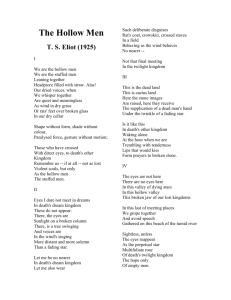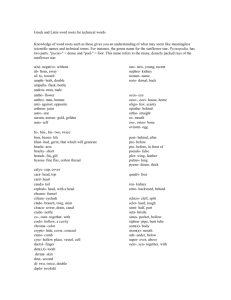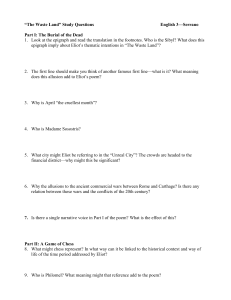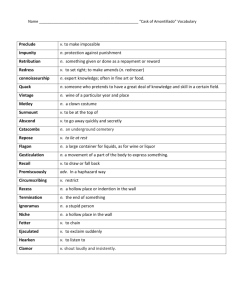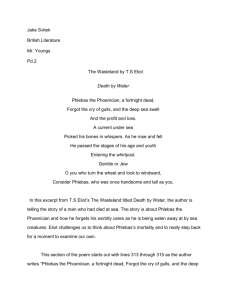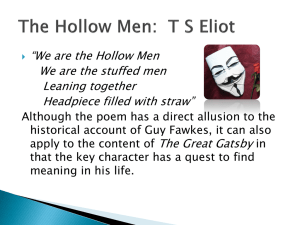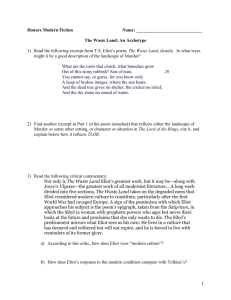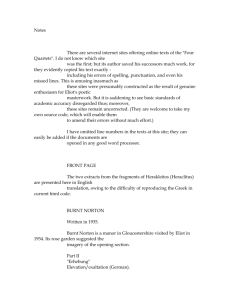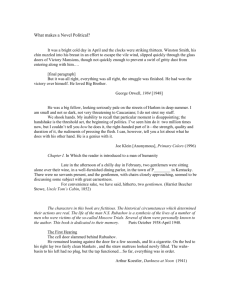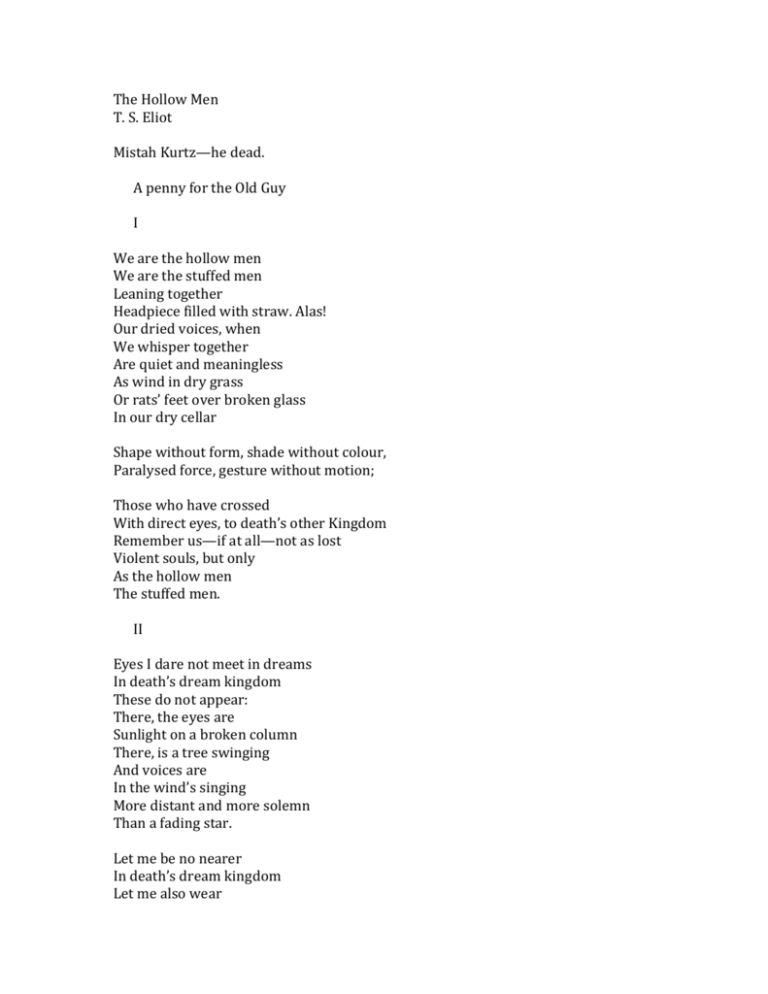
The Hollow Men T. S. Eliot Mistah Kurtz—he dead. A penny for the Old Guy I We are the hollow men We are the stuffed men Leaning together Headpiece filled with straw. Alas! Our dried voices, when We whisper together Are quiet and meaningless As wind in dry grass Or rats’ feet over broken glass In our dry cellar Shape without form, shade without colour, Paralysed force, gesture without motion; Those who have crossed With direct eyes, to death’s other Kingdom Remember us—if at all—not as lost Violent souls, but only As the hollow men The stuffed men. II Eyes I dare not meet in dreams In death’s dream kingdom These do not appear: There, the eyes are Sunlight on a broken column There, is a tree swinging And voices are In the wind’s singing More distant and more solemn Than a fading star. Let me be no nearer In death’s dream kingdom Let me also wear Such deliberate disguises Rat’s coat, crowskin, crossed staves In a field Behaving as the wind behaves No nearer— Not that final meeting In the twilight kingdom III This is the dead land This is cactus land Here the stone images Are raised, here they receive The supplication of a dead man’s hand Under the twinkle of a fading star. Is it like this In death’s other kingdom Waking alone At the hour when we are Trembling with tenderness Lips that would kiss Form prayers to broken stone. IV The eyes are not here There are no eyes here In this valley of dying stars In this hollow valley This broken jaw of our lost kingdoms In this last of meeting places We grope together And avoid speech Gathered on this beach of the tumid river Sightless, unless The eyes reappear As the perpetual star Multifoliate rose Of death’s twilight kingdom The hope only Of empty men. V Here we go round the prickly pear Prickly pear prickly pear Here we go round the prickly pear At five o’clock in the morning. Between the idea And the reality Between the motion And the act Falls the Shadow For Thine is the Kingdom Between the conception And the creation Between the emotion And the response Falls the Shadow Life is very long Between the desire And the spasm Between the potency And the existence Between the essence And the descent Falls the Shadow For Thine is the Kingdom For Thine is Life is For Thine is the This is the way the world ends This is the way the world ends This is the way the world ends Not with a bang but a whimper. Online text © 1998-­‐2010 Poetry X. All rights reserved. From The Hollow Men | 1925 On "The Hollow Men"
Grover Smith
Although "The Hollow Men" is not a mere appendage to The Waste Land, it may most profitably be read as an extension
of the same design of quest and failure. The quest has already failed once when the poem opens. The history of Kurtz in
"Heart of Darkness" conforms to the general pattern. Conrad may often be understood best through the study of primitive
rituals of succession, initiation, and fertility. That Kurtz has been initiated into the tribe, becoming its shaman, its "rain
and fine weather" maker, and that he has been ceremonially worshiped and appeased, seems an express symbol of his
disastrous descent into the dark places. The gracious figure of his "Intended," from whom he has turned to immerse
himself in the shadows, represents the light which Marlow, shaken by his own knowledge of the horror, is scarcely able to
credit, except as either an illusion of the innocent or an ideal of the courageous. What happens actually to Kurtz happens
figuratively to Marlow, who voyages into a hell so dreadful that he comes back unconvinced of any other reality. The
sheer Manichaeism of the revelation only narrowly fails to overwhelm with darkness Marlow as well as Kurtz. Kurtz,
after undertaking to combat darkness and devils, yields to them and is installed in the midst of them and, despite his final
relative victory of self-knowledge, cannot avert his damnation. The whole design approximates that of hero myths, but it
combines with curious subtlety the quest to subdue evil with a quest to restore the god overtaken by death in the guise of
life. In a sense Kurtz is like the Fisher King and Marlow is like the quester, but Kurtz has been a quester too.
The main parallel between "Heart of Darkness" and "The Hollow Men" consists in the theme, implicit throughout the
latter, of debasement through the rejection of good, of despair through consequent guilt. In Part II of the poem the
speaker confesses the impossibility of facing "the eyes," even in dreams, in the dream kingdom of his world; and in his
imagination he encounters only their symbolic counterparts--sunlight, a tree, voices in the wind. The sunlight, however,
shines only on "a broken column" among the broken desert images. His inability to return and brave the eyes resembles
Tiresias' state after the scene in the Hyacinth garden. In The Waste Land the lost eyes are those of the protagonist himself;
here they are the upbraiding eyes of one incarnating his lost redemption: the speaker takes refuge in apathy; he desires to
think of himself only as a scarecrow. He shrinks from everything but concealment among the other hollow men and
wears, with them,
Such deliberate disguises
Rat's coat, crowskin, crossed staves
In a field.
What he cannot contemplate is the reproach of
... that final meeting
In the twilight kingdom,
when at length he may meet the eyes in the real world of the dead.
The scarecrow symbol (like Hawthorne's "Feathertop") is appropriate to designate not only the ineptness and spiritual
flaccidity of the speaker but, like the "tattered coat upon a stick" in Yeats's "Sailing to Byzantium" (1927), his inability to
attain love. If one turns back to The Golden Bough and to some of the most ancient as well as most persistent rituals of
pagan Europe, it is the straw man who seems to have functioned in certain of the fire festivals as a sacrificial
representative of the vegetation spirit or as a scapegoat ridding his folk of accumulated ill-chance. The commemoration of
the fifth of November itself reflects the custom of burning in effigy the bearer of local guilt; the accident of the season--
for Guy Fawkes Day shortly follows All Souls'--may have suggested kindling traditional autumn fires for the modern
culprit. A connection between the straw man and the Fisher King will be easily apparent, for Eliot's hollow men re-enact
the distress of the mutilated Tiresias.
The figurative straw dummies of the poem suffer both physically and spiritually. How they themselves have erred, the
poem does not demonstrate. It is plain enough, however, that they are all but damned; and not for nothing is there an
allusion here, as in "The Burial of the Dead," to the third canto of the Inferno, where those, who "lived without blame,
and without praise," are doomed to abide at Acheron without crossing into hell. But it is meaningful that the hollow men
are not bound to such a torment as theirs: to follow the whirling ensign, goaded by hornets and wasps. Instead they are
like the throng awaiting (with "pennies for the Old 'Guy'") the barge of Charon to ferry them across to their everlasting
sorrow in the depths. The eyes, terrible and unrelenting, even resemble the glowing coals of Charon's eyes, as described
in both the Aeneid and the Commedia, or the streaming eyes of the demon in Kipling's "At the End of the Passage." But
the very possibility of descending, of not being forced to remain on the hither shore, paradoxically signifies hope.
Miraculously, the eyes that may reappear beyond the river portend salvation. As commentators have recognized, they are
comparable to the eyes of Beatrice in the Purgatorio (XXX-XXXI). For the pattern of descent and ascent implies that
having plunged into hell, the hollow men may find paradise. Part IV of the poem establishes a geography: the scarecrows,
loitering beside "the tumid river" (a fixture also of "Heart of Darkness"), are trapped in Ezekiel's valley of bones, where,
as in the "circular desert" of The Family Reunion, their suffering seems futile. Theirs is the "dream kingdom" where the
eyes are but a memory. They must invade the "other kingdom," the "twilight kingdom" of actual death, which, after
further purgatorial trial, may vouchsafe to them, through the eyes of pain and joy, a way upward, even to the
"multifoliate rose" of the final cantos of the Paradiso, to "the perpetual star," a symbol of the Holy Virgin. The way up
and the way down are the same; the landscape is not Dantean except in so far as its moral and emotional processes match
the allegory of the Commedia. And here, apparent hell is potential, though unrealized, purgatory.
In "Heart of Darkness" as in the Commedia, the feminine symbol, a prototype of the eyes in "The Hollow Men," charts
the quester's pilgrimage into the region of pain; Kurtz's descent is irretraceable. But Dante's leads finally upward to his
vision, beyond the eyes, beyond even the celestial spheres. And "The Hollow Men" has a similar pattern; moreover, as
Genevieve W. Foster has shown in her Jungian analysis, the eyes, the rose, and the star are equivalent to the ''Grail" of
The Waste Land. So, too, is the tree, recurring in Coriolan and "New Hampshire," and, through the children in the leaves,
in "Burnt Norton" also. (Here it ironically reminds one of Kurtz, "a tree swayed by the wind.") "The Hollow Men" would
re-express the affirmative way by abjuring lust, the false center, the "prickly pear" of Part V, circled in a whirling or
whirlpool motion, and by declaring the speaker's hope for the eyes. (In the negative way, the abandonment of lust would
have to be ratified by renunciation of the affirmative symbol and by evacuation of desire.) But attainment of the vision,
according to "The Hollow Men," is remote indeed. The agony of "Lips that would kiss," the unalleviated "anguish of the
marrow / The ague of the skeleton," lacerates the heart with proximate desire.
The first four lines of Part V parody "The Mulberry Bush," substituting for the fertility symbol connoting love (as in the
legend of Pyramus and Thisbe) an image purely phallic. And echoing the chant of the May games, "Here we go gathering
nuts in May . . . At five o'clock in the morning," with its reminiscence of the Maypole dance and the "country
copulatives," they underscore the sexual nature of the plight with which the poem deals. In this terminal section, one is
back, so to speak, in the marriage chamber of Eliot's "Ode," where sex has gone wrong. And in spite of the plain
statement that the hollow men must remain "sightless" unless the rose reappears, love, along with powers of creation and
repentance, is still sought in the world of nightmare.
With every effort to make the potential become actual a "Shadow" interferes. This, whatever its private value, has in the
poem no clear conceptual reference. It implies Prufrockian inertia incapable of connecting imagination and reality, a
defect of kinesis, in part a volitional weakness and in part an external constraint. Deathlike, it hinders even the attempt at
prayer through which the speaker might come into the "Kingdom" of pure actuality beyond. Eliot's threefold grouping of
contrasts between prospect and fulfilment comprehends three failures. The oppositions of potentiality and actuality are not
the Aristotelian or Thomistic ones; they blur as the enumeration passes from "potency" and "existence" to "essence" and
"descent," but each constitutes an antithesis compatible with Aristotelian dialectic. Even "motion," normally actual, can fit
into the potential category through its special meaning of "initial impulse," by which it contrasts with "act:" Each of the
three groups (by ambiguities) recapitulates the preceding, until by accumulation all three groups combine in the third, just
as, according to Aristotle, the soul includes in its highest powers those of the inferior species. Perhaps the first group
chiefly connotes sex; the second, sex and creation; the last, sex, creation, and salvation.
From T.S. Eliot’s Poetry and Plays: A Study in Sources and Meaning. Chicago: University of Chicago
Press, 1956.
J. Hillis Miller
In "The Hollow Men" all the richness and complexity of culture which gives "The Waste Land" such thickness of texture
disappears. The poem takes place in a twilight realm of disembodied men and forces. The complexity of relations making
up the subjective realm in Eliot's ideal descriptions of it is replaced by the vagueness and impalpability of "Shape without
form, shade without colour, / Paralysed force, gesture without motion" (CP, 79). The hollow men are walking corpses
("Mistah Kurtz - he dead"), and their emptiness is the vacuity of pure mind detached from any reality. They are cut off
from one another. Their voices are whispers, "quiet and meaningless" (CP, 79). Groping together, they "avoid speech"
(CP, 81). They are detached from nature, and live in a place which is devoid of any spiritual presence, a "dead land," a
"cactus land," a "valley of dying stars," hollow like the men themselves (CP, 80, 81) The eyes of the hollow men are not
only averted from one another, but from those other eyes, the returning look from the divine place which those who cross
"with direct eyes" to "death's other Kingdom" will encounter. There are no eyes in the hollow valley, and the empty men
are bereft of God. Even within their own hollowness detachment is the law. The "Shadow" which falls between idea and
reality, conception and creation, emotion and response, desire and spasm, potency and existence (CP, 81, 82), is the
paralysis which seizes men who live in a completely subjective world. Mind had seemed the medium which binds all
things together in the unity of an organic culture. Now it is revealed to be the Shadow which isolates things from one
another, reduces them to abstraction, and makes movement, feeling, and creativity impossible. "The Hollow Men" is an
eloquent analysis of the vacuity of subjective idealism, and the state of the hollow men appears in Eliot's later work as the
"distraction, delusion, escape into dream, pretence" (CPP, 210) of the unenlightened people in his plays, each one of
whom is a "fugitive from reality" (ES, 70), or as that horrid form of hell described in Murder in the Cathedral, the hell of
"the Void," of "emptiness, absence, separation from God" in "the empty land/Which is no land," where "there are no
objects, no tones,/No colours, no forms to distract, to divert the soul/From seeing itself, foully united forever, nothing with
nothing" (CPP, 210).
If "The Hollow Men" shows where idealism leads, it offers a fleeting glimpse of a way out of emptiness. Though nature,
other people, and God have an almost entirely negative existence in the poem, they do exist as something outside the
hollow men. The poem places the "stuffed men" in the context of an external world, God's world. Their state is defined as
that of the trimmers in the third canto of the Inferno, those wretched souls, "gathered on this beach of the tumid river,"
who lived without blame or praise, and, like the neutral angels, were neither rebellious nor faithful to God, but lived for
themselves. Far better to be one of the "lost/Violent souls" (CP, 79), for they were at least capable of damnation, as
Baudelaire, in Eliot's essay, "walked secure in this high vocation, that he was capable of a damnation denied to the
politicians and newspaper editors of Paris" (SE, 344). To recognize the possibility of damnation is in a way to become
capable of it, and therefore capable of the salvation which is denied to the trimmers. The trimmers in Dante have no hope
of another death, but Eliot's hollow men understand dimly that if they endure the death which is prelude to rebirth they
have some hope of salvation. Though Eliot's language is deliberately ambiguous, it implies that the sightless eyes of the
hollow men may see again, and confront the divine eyes which are "The hope only/Of empty men" and will reappear as
"the perpetual star/Multifoliate rose" of heaven itself (CP, 81). The idealists of "The Hollow Men" have stepped out of
themselves into the barrenness of an external world, and the fragments of the Lord's prayer ("For Thine is/. . . For Thine
is the" [CP, 82]) which they mutter at the end of the poem are moving appeals to a God who may be infinitely distant,
but who is independent of their minds and therefore may have power to save them.
From Poets of Reality: Six Twentieth-Century Writers. Harvard University Press, 1965.
David Spurr
The Hollow Men (published 1925) portrays a poetic consciousness in which intense nostalgia for a state of Edenic purity
conflicts with the paradoxical search for a more enduring form of order through acts of denial and alienation. To the
common observation that The Hollow Men expresses the depths of Eliot's despair, one must add that the poet in a sense
chooses despair as the only acceptable alternative to the inauthentic existence of the unthinking inhabitants of the waste
land. Eliot himself saw this kind of metaphysical despair as more intellectual than emotional. He says of Pascal, a
"Christian thinker" with whom be clearly identifies:
His despair, his disillusion, are ... no illustration of personal weakness; they are perfectly objective, because
they are essential moments in the progress of the intellectual soul; and for the type of Pascal they are the
analogue of the drought, the dark night, which is an essential stage in the progress of the Christian mystic.
Principles of intellectual order control the despair of The Hollow Men as well, in the way the poem consciously evaluates
experience in abstract terms, distinguishes between antithetical states of being, and establishes, both in form and subject
matter, the archetype of the Negative Way as an alternative to disorder as well as to the illusory order of visionary
experience. The following pages examine formal and thematic elements of the poem as representing the progress of
Eliot's own "intellectual soul," and then show this progress as frustrated by the poet's attraction to a visionary imagery.
The Hollow Men replaces the richly chaotic style of The Waste Land with an austerity of expression that prepares for the
contemplative mode of Ash-Wednesday. In what Bergonzi has called "a virtual surrender to the silence," the formal
strategy of The Hollow Men, like its thematic content, seems designed to demonstrate how effectively the shadow of the
inarticulate falls between the conception and the creation of an artistic work. Formal aspects of the poem imitate the
characteristics of the hollow men it portrays. For example, their desire to "avoid speech" finds a counterpart in the poem's
general paucity of utterance: the technique of constant repetition and negation--"The eyes are not here / There are no eyes
here"--manages to employ only about 180 different words in a work 420 words long. The "Paralysed force, gesture
without motion" applies not only to the men themselves but also to the poem as a whole, which exhibits little narrative
progression in the conventional sense and eschews verbs of direct action.
As the hollow men grope together, form prayers to broken stone, and whisper meaninglessly, so the poem itself gropes
toward a conclusion only to end in hollow abstraction, broken prayer, and the meaningless circularity of a child's rhyme.
The conscious reduction of poetic expression to a bare minimum does away with metaphor and simile and produces a
final section of the poem almost completely devoid of modifiers. The poem avoids capitulation to the silence of the
inarticulate by relying on a highly structured syntax that tends to order experience in terms of binary opposition: "Shape
without form, shade without colour," or "Between the idea / And the reality / Between the motion / And the act."
The quality of a poetic style marked by verbal austerity and relentless negation forms a structural counterpart to a
thematic strategy that repudiates the validity of human experience at every level. In this respect the poem expands upon
the theme of denial explored as part of the individual's search for meaning in The Waste Land. In modern existential
terms as well as those of traditional Christianity, the Negative Way leads ultimately to an encounter with nothingness
which, paradoxically, can inspire the individual with faith in God. Kierkegaard seeks to explain this paradox by showing
that dread [aengste], the simultaneous fear and intense awareness of nothingness, opens up the possibility of faith in an
infinite beyond human life by "laying bare all finite aims and discovering their deceptions," by revealing the
"deadendedness" of life itself: "When the discoveries of possibility are honestly administered, possibility will then
disclose all finitudes and idealize them in the form of infinity in the individual who is overwhelmed by dread, until in turn
be is victorious by the anticipation of faith." The via negativa brings the individual to a terminal point marking the
boundary between the finite and the infinite.
The Hollow Men explores this boundary situation in its images of finality or extremity and in a thematic structure
comprising two different states of being. The poem's speaker anticipates with dread "that final meeting"; the men grope
together "In this last of meeting places"; the final section, in its generalized abstraction of all that has gone before, tells us
that "This is the way the world ends." The Dantescan image of the lost souls "Gathered on this beach of the tumid river"
belongs to a boundary motif that recurs throughout Eliot's poetry: Prufrock escapes from the world of skirts and teacups to
the world of visionary imagination via a "walk upon the beach." The protagonist of The Waste Land sits down and weeps
"By the waters of Leman," then upon the shore "with the arid plain behind me." The sea of The Dry Salvages "is the
land's edge also." The persona of The Hollow Men has arrived, intellectually and imagistically, at the outer limit of one
world only to find that its ''deliberate disguises" conceal a finite lack of possibility: between the potency and existence
"Falls the Shadow."
From Conflicts in Consciousness: T.S. Eliot’s Poetry and Criticism. Urbana: University of Illinois Press,
1984.
Robert Crawford
The epigraph, "A penny for the Old Guy," stresses that Eliot's poem relates to ceremonial effigies. Here, as in The Waste
Land, Heart of Darkness is important. "Mistah Kurtz--he dead" emphasizes a connection between savage ritual and Eliot's
crossed staves. To obtain power by embracing darkness, Kurtz deified himself in line with primitive belief; ironically,
Eliot's speaker dresses in relics of forgotten ritual out of a sense of total impotence, wishing to avoid a horrid dusk: "Not
that final meeting / In the twilight kingdom." It is landscape like Dowson's, "Hollow Lands" where, in "the twilight of the
year", "dead people with pale hands / Beckon" by a "weary river", "where pale stars shine" where, at passion's enactment,
"There fell thy shadow." But the poem's world, lit by the half-light of inaction, was a transmutation of Eliot's own
suffering. Vivienne, who had felt The Waste Land to be a part of herself, saw 'The Hollow Men' as a fitting follow-on,
and related it to her own nightmares. But, as before, the personal world and that of late nineteenth-century poetry are
sieved through anthropological ideas, emotion distributed among unsettled voices, narrative, optative, and choral. The
poem is typographically complex. The first section's 'Kingdom' may not be section three's 'kingdom'. Certainly 'death's
other kingdom' (my italics) suggests that the speakers' inane life is only another form of death. So, for Sweeney Agonistes
'Death or life or life or death / Death is life and life is death.' Cornford had quoted the Euripidean question, 'who knows if
to be living be not death? Through anthropology Eliot resuscitates the idea of the living dead, so common in late romantic
poetry, where Death-in-Life is the eternal king. Eliot's Hollow Men share their hopelessness with the inhabitants of the
City of Dreadful Night.
[. . . .]
The poem concerns degradation of language and ritual, failings of word and Word. Eliot's witty 1918 truncation of an
Arnoldian phrase prefigures the Hollow Men's predicament; Clive Bell, 'lingering between two worlds, one dead', has the
vice of inane mediocrity, incapable of 'icy inviolability, or violent fury'. His being 'the Matthew Arnold of his time' again
connects, through the scarecrow image, with the Hollow Men who, like so many of Eliot's literary adversaries, are
afflicted with a stuffed language, emptily 'poetic', the degradation of great poetry-Leaning together
Headpiece filled with straw. Alas!
After the starkly factual 'Headpiece filled with straw' comes that most absurdly poetic word of all, indicating the speaker's
weakness. Such childish poeticizing is reinforced, in directing us to the level of the infant, by the 'penny for the Old Guy'
epigraph, by the dressing up as a scarecrow, and by the nursery rhyme, 'Twinkle twinkle little star', which inescapably
underlies the line 'Under the twinkle of a fading star'. This use of nursery rhyme looks back to The Waste Land with its
'London Bridge is falling down falling down falling down' and anticipates another explicit nursery rhyme which, in
slightly distorted form, opens section V of 'The Hollow Men'. Other forms of words instilled into the young are also
present. The Lord's Prayer is quoted in the repeated fragment ‘For Thine is the Kingdom' but the earlier uses of the word
kingdom, particularly when it has a capital 'K', must already have prompted questions about allusion to this fundamental
Christian rite, and about how it relates to those `prayers to broken stone’. It is hard to avoid thinking that the hope of 'Thy
Kingdom come' finds its opposite in
Let me be no nearer
In death's dream kingdom
which becomes an anti-Lord's Prayer, addressed to an unnamed hearer who may be the god of a universe of barrenness
and death. 'The Hollow Men', not 'The Hippopotamus', is Eliot's most blasphemous poem.
Ideas of childishness, linguistic degeneration, and confusion support the central theme of the degradation of essential
ritual. The barely glimpsed possibility of Christian hope plunges to crazy childishness.
Here we go round the prickly pear
Prickly pear prickly pear
Here we go round the prickly pear
At five o'clock in the morning.
'Ritual,' Eliot wrote in 1923, 'consisting of a set of repeated movements, is essentially a dance.’ He called The Sacred
Dance 'an excellent study of primitive religious dances', and read how these were performed round sacred trees, but also
'how often with the decay of old faiths the serious rites and pageants ... have degenerated into the sports of children'. It
was ten years since Eliot had been interested in Ecstasy and Dance Hypnosis among the American Indians, and had read
in King about the lively 'moonlight dances' of Bushmen. These would resurface, bereft of fun, in the childish dance of
'The Hollow Men', as later, much more lightly in the Jellicle Cats’ `Reserving their terpsichorean powers / To dance by
the light of the jellicle Moon.'
Though anthropological theories of religious degeneration were becoming outdated, Eliot was familiar with the version
propounded by, for instance, Andrew Lang in his Making of Religion. Tylor, about whose theories Eliot had been
sceptical, was particularly strong on connecting the mental processes of savages with those of children, connections
emphasized by Cornford, Frazer, Oesterley, Webb, Wundt, and others. Cornford's book on some of the greatest Greek
drama had as its frontispiece a Punch and Judy show. Eliot was fascinated by the idea which Cornford had put forward
'in "The Origin of Attic Comedy", [that] this [medicine-man ] Doctor may be identical with the Doctor who is called in to
assist Punch after he has been thrown by his horse'.
Though primitive man may be something of a mystic, the distant voices and fading star in Eliot's poem show no
'prelogical mentality' from a golden age of childlike innocence. The distant fading signals a run-down age of degenerate
belief. That it had paradisal origins is a simplistic assumption. His criticism of Oesterley's work makes it clear that for
Eliot a ritual's origins may be as meaningless as is its present form. He attacks Oesterley for falling into 'the common trap
of interpretation' by formulating intelligible reasons for the dancing of a primitive. Eliot asserts that it is perfectly possible
to claim 'that primitive man acted in a certain way and then found a reason for it'.
The last section of 'The Hollow Men' in particular places its rituals in a crazy emptiness. The verve of the nursery rhyme
spins us round in a sinister way, since it is disturbing to see the familiar 'mulberry bush' of the children's rhyme replaced
with the arid 'prickly pear', making the rhyme like some distorted survival of a primitive chant. Eliot's substitution makes
this seem an infertility dance. As an American plant, 'prickly pear' also connects with his own childhood in a society
whose religious values seemed atrophied.
Section V's voices are the most complex. First comes the choral nursery rhyme, linked typographically with the italicized
passages placed against the right-hand margin to differentiate them from the rest of the text. These appear to be parts of
the Lord's Prayer, but are confused by the addition of the complaint in the same typographical form, 'Life is very long,’
appropriately enough from the more primitive world of An Outcast of the Islands. A third voice, represented by normal
type and placed in the conventional part of the page, is itself like another ritual, a fact emphasized by the incantatory
effect of semantic and lexical patterning in the repeated, only slightly varied form,
Between the a
And the
b
Between the c
And the
d
Falls the Shadow
This tripartite distinction, easy to uphold on the grounds of typography, is complicated, however, by the fact that
fragments of the italicized Lord's Prayer passage find themselves brought in from the right-hand margin to form part of
the body of the text when, further truncated, they make up the liturgical stutter of
For Thine is
Life is
For Thine is the
before a final all-embracing italicized section, looking back in its typography, placing, and, most importantly, its rhythm,
recalls the opening nursery rhyme chorus, but gives it a universal voice which seems to include all that we have heard
before in what is now a ritual chant ending with an appropriately childlike sound,
This is the way the world ends
This is the way the world ends
This is the way the world ends
Not with a bang but a whimper.
This combination of various voices, including the choric, makes the fifth section distinctly dramatic in its fragmentation,
and, clearly deriving from the techniques employed in The Waste Land, also paves the way for the fragmentary drama of
Sweeney Agonistes.
From The Savage and the City in the Work of T.S. Eliot. Clarendon Press, 1987. Reprinted with permission
of the author.
Return to T. S. Eliot


